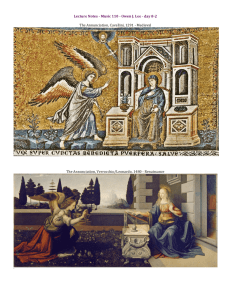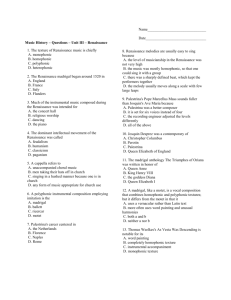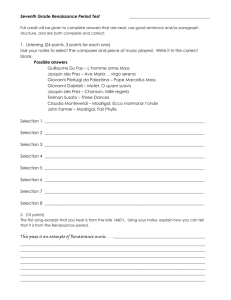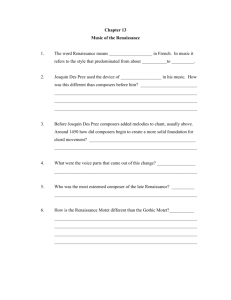Renaissance Music – The Basics Most music is vocal during this
advertisement
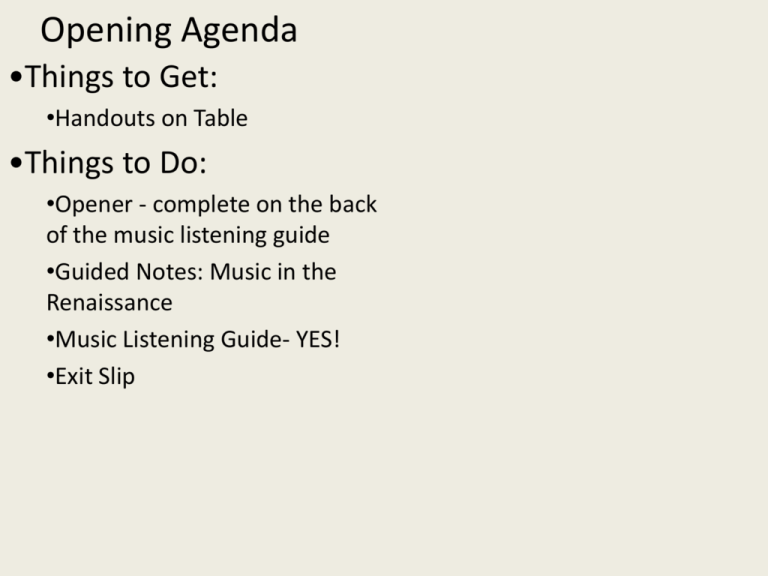
Opening Agenda •Things to Get: •Handouts on Table •Things to Do: •Opener - complete on the back of the music listening guide •Guided Notes: Music in the Renaissance •Music Listening Guide- YES! •Exit Slip Opener- Renaissance Art Review On each of the pictures shown below, complete the following: 1) Name the artwork and creator 2) Write one sentence about the picture you see (controversies, facts, etc.) 1 4 2 3 1430-32 5’2’’ Bronze 1504 18’ Marble Renaissance Music Palestrina’s Pope Marcellus Mass (circa 1562) By the end of class you should to know: Terms • Sacred • Secular • Harmony • Polyphony • Eleison Renaissance Music Forms • Mass • Madrigal • Motet Renaissance Musicians • Josquin des Prez • Giovanni de Palestrina Renaissance Music – The Basics • Most music is vocal during this period – instruments were not yet standardized or mass-produced • Two categories of music: Sacred – for use in Catholic churches (remember, Europe, at the time, was almost entirely Catholic) Secular – everything else: ie. dancing, love, etc. • Sacred music written in Latin • Secular music written in vernacular (local language) Lute: http://www.music.iastate.edu/antiqua/mp3/Musica_Antiqua_have_you_seen.mp3 Recorder: http://www.music.iastate.edu/antiqua/mp3/musica_antiqua_merry_month_of_may.mp3 Harmony • Harmony: when two or more pitches sound at the same time • Therefore, if you have two or more singers on different pitches, you have harmony Harmony INTO Polyphony • If this harmony sounds like two completely independent lines of melody, you have polyphony. multiple (Greek) sound (Greek) Poly phony Polyphony Application • While listening to this classic Beatles’ tune, identify the parts of the song that contain polyphony. – Intro, Verse 1, 2, 3, Bridge, Chorus? Where is it? http://www.youtube.com/watch?v=taADLPtyDb0 Josquin des Prez • Dates of Life: 1450-1521 • Location of Birth: Belgium or France • Patrons: Julius II • Interesting Fact: • He was directing the Sistine Choir while Michelangelo was painting the ceiling and Raphael was creating the School of Athens • Influences: Master of multiple genres, specifically the motet • Important Fact: One of the greatest composers of complex polyphonic music – called the High Renaissance style. Josquin des Prez Structure of Music • Blended polyphony and 3 tone chord harmonies • Matched words with music (wordmatching) • All voice parts composed at one time – united parts rhythmically and harmonically • Preferred motet to the strict tradition of the Mass • required attentive/educated audience to be appreciated Form: Motet des Prez’s favorite genre • • • • Popular genre of polyphonic music during Renaissance Always vocal Usually sacred (remember, sacred = church music) Voices combine into chords as they change, creating shifting consonance and dissonance Josquin’s Ave Maria http://www.youtube.com/watch?v=LUAgAF4Khmg • “Ave Maria” = “Hail, Mary” Musical setting of the traditional “Hail, Mary” prayer used in many Christian churches. • Voices overlap, hear how the notes form different harmonies as the lines change one by one. • Listen for dissonance resolving to consonance! Josquin’s Ave Maria •Entering voices parts indicated by red marks •Voices range from high to low: soprano, alto, tenor, bass The Church, mix-tapes, and polyphony When composers wrote church music, they often recycled (or sampled) the tunes of secular songs – even songs about drinking and sex – just like today’s artists sample songs from earlier years. Ray Charles – I’ve Got a Woman “The song builds on "It Must Be Jesus" by the Southern Tones, that Ray Charles was listening to on the radio while on the road with his band in the summer of 1954….” “…built along a gospel-frenetic pace with secular lyrics and a jazz-inspired rhythm and blues.” (wikipedia) Like to hear it? Here it go… http://www.youtube.com/watch?v=Mrd14PxaUco – Ray Charles http://www.youtube.com/watch?v=AvCbVLZW4EY – Southern Tones Giovanni Palestrina • Dates of Life: 1525-1526 • Location of Birth: Palestrina, Italy • Patrons: Pope Marcellus • Interesting Fact: • He was the choirmaster of the Julian Choir that performed exclusively in St. Peter’s Basilica. He was also the music director for the Vatican. • Influences: Gregorian Mass, Renaissance restraint, and the Counter-Reformation • Important Fact: • He is the greatest composer of church music and he is known for his restrained polyphony. Giovanni Palestrina • Abandoned secular music style of des Prez • His compositions are typified as very clear, with voice parts well-balanced and beautifully harmonized. • strict style created music that was always full and fluid • Restrained dissonance – 6 voices showed complex polyphony could still be pleasing to the ear • high point of sacred music in late Renaissance Form: Mass center of religious life •The Mass is the weekly (or daily) worship service in the Catholic Church. Often times entirely new music was written for the mass. The Mass is always composed of the same five basic parts: Kyrie Gloria Credo Sanctus-Benedictus Agnus Dei King George Can’t Sing Alto Mass • The sections always have the same basic texts. Kyrie - Greek: Kyrie - English: Kýrie, eléison Christe, eléison Kýrie, eléison Kýrie, eléison Lord, have mercy Christ, have mercy Lord, have mercy Lord, have mercy Palestrina’s Pope Marcellus Mass Listen for the words. They repeat constantly in all six voices – it’s polyphony: Kýrie, eléison Christe, eléison Kýrie, eléison Kýrie, eléison http://www.youtube.com/watch?v=16cH1RZcPKs Palestrina’s Pope Marcellus Mass According to legend, this piece caused early church fathers to allow polyphony to stay as part of the Mass. Remember, they were upset that composers were writing religious texts to the music of bawdy songs. Palestrina’s music showed them that polyphony could be refined and worthy of use in church ceremonies. Music Listening Guide Title: Kyrie Composer: Palestrina Date Composed: 1562 Period/Style: Renaissance/Mass Featured Instruments: Voices ONLY! Palestrina’s Pope Marcellus Mass •Compare Palestrina to Josquin. •P’s is generally considered to be more refined polyphony than earlier composers (Josquin). •For this reason, Palestrina is probably the best known and most popular composer of Renaissance polyphony, and the greatest composer of church music of the period. Form: Madrigal • Popular genre of polyphonic music during Renaissance – in both Italy and England • Always vocal – between two and eight voices • Always secular • Choruses repeat, like today’s pop music. Voices enter and drop out suddenly to highlight the text • Music imitates words: called text painting. • Fun & spicy topics: love, sex, drinking, partying, etc. “Fair Phyllis I Saw Sitting All Alone” • Popular madrigal by John Farmer (c. 1570 – c. 1601) • In four voices (soprano, alto, tenor, bass) • Words in English • Voices have slightly different rhythms. This overlap creates polyphony – 4 voices with equal importance • Secular subject matter sometimes created innuendos (double meanings – sometimes sexual or inappropriate topics) “Fair Phyllis” (cont.) Fair Phyllis I saw sitting all alone Feeding her flock near to the mountain side. The shepherds knew not, they knew not whither she was gone, But after her lover Amyntas hied, Up and down he wandered whilst she was missing; When he found her, O then they fell a-kissing. “Fair Phyllis” (cont.) Things to notice: • Word painting: soprano alone sings the line “Fair Phyllis I saw sitting all alone,” (because she’s alone) • Word painting: “Feeding her flock…” has all voices, (because a flock = lots of sheep) • Word painting: “Up and down he wandered…” – the voices follow up and down • “Hied” = “hurried” – an archaic English word “Fair Phyllis” (cont.) More things to notice: •Elision: Two phrases may overlap, making the beginning and ending of both happen at the same moment in time. •Listen for elision – do you hear any new sentences formed by the combination of lines? Recap: • 3 forms: Mass, motet, madrigal • Mass and motet in Latin, madrigal in English • Palestrina = Italian • Josquin = Belgium/French • Polyphony = overlapping voices of equal importance • Consonance = 2 or more pitches that resonate pleasingly/smoothly together • Dissonance = 2 or more pitches that somewhat clash Exit Slip • 1) Identify the composer, form, and title of the following clips: – Clip One: – Clip Two: – Clip Three: • 2) How is the structure of Des Prez and Palestrina similar? • 3) Discuss how historical events influence the difference between the music of Des Prez and Palestrina. Medieval and Renaissance Instruments killer/filler • http://www.music.iastate.edu/antiqua/instru mt.html
